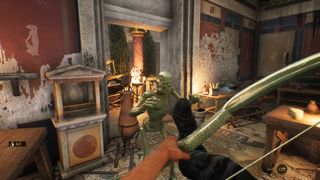
This article contains spoilers for the Forgotten City
The Forgotten City is mainly a chill detective game about exploring a lush roman metropolis, solving puzzles by talking to people and manipulating a cleverly constructed time-loop. But there's one quest in the game that's possibly the most disturbing thing I've experienced all year. Titled 'The Gilding', it sees you explore a labyrinthine palace while gradually unravelling a nightmarish tale of tragedy, torture, and toxic love.
Like most bad things in life, The Gilding starts with a greedy man trying to get his hands on something that doesn't belong to him. That man is named Desius, an avaricious roman merchant who views the mythical King Midas as an aspirational figure. Found at his market-stall, Desius wants to 'retrieve' a magical bow from the nearby shrine of Diana, arrows fired from which will transform whatever they strike into gold. The only problem is stealing anything in The Forgotten City breaks the Golden Rule, destroying the entire settlement and forcing you to flee into a portal that transports you back to the start of the day.
But Desius has a plan. If he can find another bow, any bow, all he needs to do is wrap it in gold leaf and swap it for the real deal. Then, technically, he wouldn't be stealing the bow, he'd be replacing it. By 'he', Desius of course means 'you'. Find him a bow and help him switch it for the one in Diana's shrine, and he'll split the dividends with you 50/50.
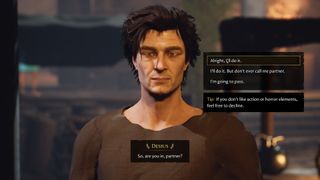
I won't bother going over how you acquire this replacement bow, as like most quests in The Forgotten City it involves convoluted time-travel shenanigans. Ultimately, you get one, and go to the shrine to swap it. The second you do, however, a trap activates, locking you inside the shrine. Not to worry, Desius says, just slide the bow under the door and he promises that he'll release you. Swear on my mother, guv. Honest as Jupiter made me.
Naturally, your character tells Desius to swivel on it, and searches for another way out of the shrine. After a little ad-hoc shrine remodelling, you descend through a network of underground tunnels that eventually emerge into an enormous palace complex filled with golden statues.
Now, this isn't unusual by The Forgotten City's standards. There are more golden statues in the city than there are living people. But the statues in the palace are different for two reasons. First, they appear horribly emaciated, and second, they immediately start trying to murder you.
The biggest gaming news, reviews and hardware deals
Keep up to date with the most important stories and the best deals, as picked by the PC Gamer team.
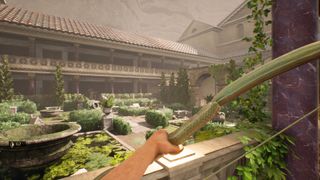
The only way you can stop the statues is by shooting them with the bow, which covers them in an additional layer of gold and kills them. But here's where things get weird. Well, weirder than a bunch of skeletal C-3PO cosplayers trying to scratch your eyes out already is. When you kill the statues, they thank you for it.
It quickly becomes apparent that the statues are literally begging for death, attacking you specifically so that you have no choice but to defend yourself. There's something deeply troubling about encountering an 'enemy' that wants you to kill them. It creates a cognitive dissonance, putting your reason and empathy at odds with your fight and flight response.
Admittedly, it's not an uncommon horror trope, even within games. In System Shock 2, the Hybrids would wail "I'm sorry" at you before swinging a pipe at your head. But it's effective here, partly because the statues look so creepy, scuttling toward you with their arms outstretched, but also because you simply don't expect it from a game that's otherwise about wandering around a nice wee town chatting with locals.
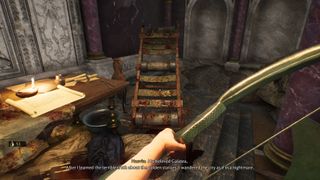
But the Gilding is only getting started. Moving further into the palace, you come across notes written by a woman named Naevia, charting her discovery of the palace and the story behind the statues. These, it turns out, were inhabitants of the city previously cursed for breaking the Golden Rule, damned to spend an eternity encased in gold. According to her notes, Naevia has dedicated herself to trying to cure the tormented souls of their curse.
A noble endeavour, but Naevia's intentions soon take a cruel turn. As you approach the palace's inner sanctum, you begin to see evidence of Naevia's 'treatments'. Bloodstains splashed on the ground, restraining equipment smeared in gold and crimson ichor. The deeper you go, the more graphic the scenes. The last few corridors resemble a gilded abattoir, with bodies strewn liberally about and walls coated in gore.
Naevia has been trying to free the statues by stripping their golden shell to get to the person underneath. But they are effectively one and the same, meaning that she's been flaying her patients alive. The statues running around the palace are the disfigured 'survivors' of her treatment, driven to mental collapse by the pain Naevia has inflicted on them. Worse, the traumatic nature of her treatments, combined with their ineffectiveness, has driven Naevia into a state of delusion where she can no longer see the damage she is inflicting.
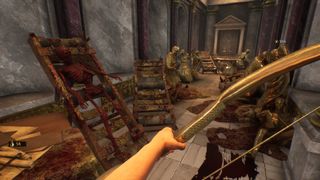
At the heart of the palace, we discover the true reason behind Naevia's efforts. In a large atrium lies the 'statue' of a woman named Galatea, strapped to a table and half-flayed. Galatea is Naevia's lover, and all the pain Naevia has caused has been part of an effort to free Galatea from her curse.
The quest can end in several ways, although there's no easy solution. The best you can do is re-cover Galatea in gold, ending her pain, while Naevia promises to cease her experiments. Alternatively, you can kill Naevia outright, but this will break the Golden Rule. In any case either choice is only temporary, as the next time you go through the time-loop, the whole day will reset, and Naevia and all the statues will be trapped once more in their cycle of violence and grief.
It's a grim and grisly tale, so much so that part of me wonders whether it belongs in the Forgotten City at all. It differs from anything else in the game in just about every way, utilising mechanics like stealth and combat that are otherwise rarely deployed, and having its own, walled-off section of the city to take place in. The tonal whiplash is stark too. The Gilding is one of the first major quests you can do, and going into it after what had previously been a fairly light-hearted adventure is really quite shocking. And stepping out from its deeply troubling conclusion to return to the game's laid-back detective work feels extremely weird. It's like putting the bear from Annihilation into an episode of Poirot. That level of existential horror feels out of place.
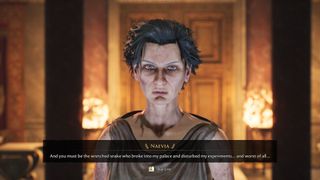
Then again, such arguments veer close to those raised about Boyfriend Dungeon, a dating sim in which one of its characters was a stalker. Just because I don't expect a game to make me feel uncomfortable doesn't mean that it should refrain from doing so. Indeed, The Forgotten City did try to warn me, giving a heads up about what was to come if I pursued the bow-swapping questline. I merely brushed the warning aside, thinking "I've played Alien: Isolation, so it can't be that bad."
And while I'm unsure The Gilding fits with the Forgotten City's general structure, I don't think the game would be the same without it. The Gilding represents the remarkable breadth of the game's storytelling talent. The way it suddenly switches into this horror mode and is instantly effective at it—weirding me out in a way that only one other game has done this year—is hugely impressive. It isn't why I would recommend playing The Forgotten City, but it is perhaps the starkest example of why the game is so engrossing.
Most Popular

